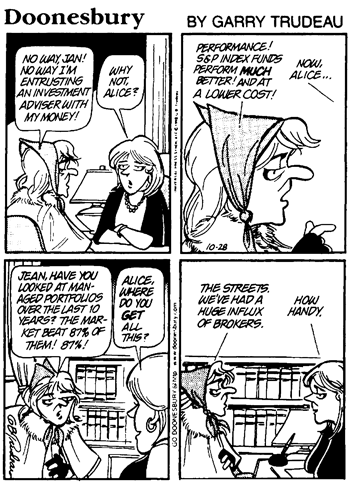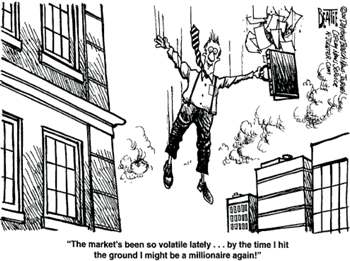I am a regular reader of popular cartoons and recently one popular cartoon called "Cathy" has been talking about the risk of the stock market and the bursting of the housing bubble. Does humor typically come before "uh oh" or does it come during the initial pain of a downturn, as a way of smiling through it (with clenched teeth)?
--Susan
It usually starts with the peak and builds in the initial stages of the decline. And you are exactly right, it appears to be some kind of collective defense mechanism for dealing with the inevitable setbacks. Back in December 1999, when the Dow Jones Industrial Average was just a few week's from its all-time high, The Elliott Wave Financial Forecast showed a few funny cultural takes on the stock market bubble and noted that the "desire for comic relief will expand rapidly in the weeks ahead." After the Dow peaked on January 14, 2000, EWFF observed a flood of comic takes on stocks. Here's one, followed by some of what EWFF had to say about it:

"Cartoonists’ repeated use of investment themes shows how deeply the market has reached into the mainstream of American life. At this point, the message is extremely bearish, as popular cartoons like doonesbury have been covering the mania on an almost daily basis. The cartoons work because a mania is pretty funny."
By July 2000, when the S&P and NASDAQ had joined in with the Dow's decline, the papers were packed full of humorous references to what was going on in the market. Here's one we showed in that month's issue and some of what EWFF had to say about it.

"Another sign of a major mood change is the “gallows humor that prevails” around Wall Street and Silicon Valley. This cartoon is one small example. Cartoonists are cracking up readers with similar pieces at such a steady rate that the editor of a digest of cartoons has established a Wall Street section to which he posts five or six additions each day. A former TV writer has just published “The Trillionaire Next Door,” a twisted look at day trading. Newsweek says, “He has developed a weird new niche: satirizing the financial pages.” After Esquire printed an April Fools Day prank about a bogus concept company that planned to give away cars plastered with ads, it was flooded with calls for the new advertising vehicles. One company called to say the author had ripped him off. FreeCars.com really does plan to give away cars as ads. Reality may be on its way back, but it still has a long way to go before it is re-established."
As we noted in our original observation about stock market cartoons (see May 1997 entry in Additoinal References), cartoonists have a way of crystalizing the human experience. Theirs is the role of the jester, which means they provide a reality check – to say what higher members of the court are too intimidated or subservient to say. And so it is with the “Kathy” strip at the top of this page. It says what almost no investment adviser or financial authority now believes: That investment assets are extremely vulnerable “across-the-board,” and “Cash is king.” It may seem weird that this understanding, which should prove invaluable to anyone who possesses it, is almost exclusively available in the comic section of the daily newspaper, but in the paradoxical world of high finance, it is perfectly appropriate.
|
